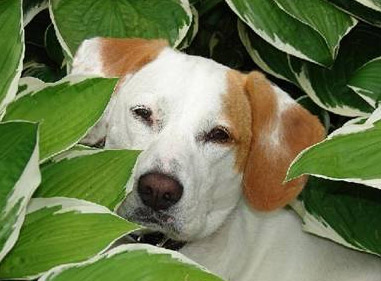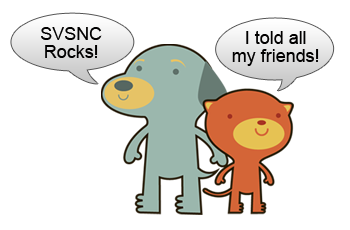Post-Surgical FAQs
 Is it okay for my pet to lick the incision? NO!!!!!!!!!!!!!!
Is it okay for my pet to lick the incision? NO!!!!!!!!!!!!!!
- If a dog licks the incision, the healing process may be delayed.
- Licking can remove stitches and cause the incision to open
- Licking can become a severe habit that is difficult to break
- Licking can cause infection as the mouth has many bacteria
- Dogs will frequently lick the incision when the owner is not watching such as at night time; if the skin looks red or excoriated the most common cause is from licking.
To stop your pet from licking the following can be tried:
- Elizabethan collar can be placed on the neck; this will not help stop your pet from scratching at the region
- Cervical collar (bite not collar) is a less awkward device and can be effective at stopping a pet from licking the surgical site
- A tee shirt can be used to cover an incision on the chest or front part of the abdomen; gather the waist of the shirt up over the dog's back and wrap an elastic band around this part of the shirt.
- If the pet is scratching at incisions you can put socks on your pet; fasten the top of the sock to the dog's limb with tape.
- Bitter apple can be applied around the incision; many dogs will continue to lick after application of this topical
- Sedatives or Antipsychotic medication in some cases is needed
When should my dog have the first bowel movement after surgery?
Many dogs will not have a bowel movement for the first 2 to 3 days after surgery. Reasons that a dog will not have regular bowel movements after surgery include:
- The dog has been fasted prior to surgery
- They frequently do not eat well when they go home
- They are fed highly digestible food that produces little stool
- Pet is in pain and won’t posture to defecate
If a pet does not have a bowel movement on the 5th day of being home, a stool softener such as Metamucil can be fed. Add Metamucil to the dog's diet, preferably mixing it in with wet food. Give half a teaspoonful twice a day to small dogs and two teaspoonful's twice a day to larger dogs. Be sure to give the dog plenty of water. It may take 12 to 72 hours for the Metamucil to be effective.
- Mix with canned food and feed it ASAP as the Metamucil will gel the food and may make it less palatable
- Pumpkin pie filling is also a great laxative
My pet had surgery and will not eat. What can be done?
Dogs:
- Most pets will not eat their regular dog food after surgery, especially if it is kibble.
- Simply add warm water and soften the kibble for the dog. Microwaving it for a few seconds to warm and give it aroma may help as well.
- Warm the food slightly in a microwave, as the food will be more aromatic; stir the food before feeding and test the temperature on the bottom side of your wrist; it should only be luke warm.
- Offer a cooked diet having a 1:1 ratio of a protein source and carbohydrate source. The protein source can be any meat (example: chicken breast, turkey breast, lean hamburger) that is low in fat and should be cooked (drain off all fat after the meat has been cooked). The carbohydrate can be pasta, potato or white rice.
- Try canned dog food; to enhance the flavor sprinkle a very small amount of garlic powder or chicken or beef broth.
- Try Hill's A/D diet available at most veterinary hospitals
- Hand feeding: place a small amount of food in the mouth so that your dog gets the flavor
Remember that most pets will not eat the first day or two after they get home from surgery due to anesthesia which can make some pets nauseous for a day or so post-surgical.
Cats:
- Simply add warm water and soften the kibble for the dog. Microwaving it for a few seconds to warm and give it aroma may help as well.
- Warm the food slightly in a microwave, as the food will be more aromatic; stir the food before feeding and test the temperature on the bottom side of your wrist; it should only be luke warm.
- Offer smelly foods that contain fish such as tuna or smelly cat foods
- Hand feeding: with your finger place a small amount of food on the roof of your cat's mouth; use a syringe to get soft food into the mouth
- Some cats will only eat dry food, try kibble if your cat normally has been fed that food
- Petting and stroking your cat frequently will help to stimulate appetite
Remember that most pets will not eat the first day or two after they get home from surgery to anesthesia which can make some pets nauseous for a day or so post-surgical.
How do I know that my dog is in pain following surgery?
Signs of pain include:
- Crying
- Biting if you get near the surgical site
- Grimacing (lips are pulled back and the dog looks anxious)
- Tragic facial expression
- Panting
- Restlessness and unable to sleep; pacing
- If abdominal surgery was done the pet will not lie down on the incision, or will continually sit up in spite of appearing very tired
- The worst pain will be for the first 2 to 3 days after surgery
What can I do to control my dog's pain?
- We offer a pain injection the time of surgery
- We also have prescription pain take home medications
- Anti-inflammatories used to control pain, ask us to dispense
- DO NOT GIVE your dog any over the counter or human pain medications
- Cool compress may help some pets especially male dogs
A cold pack may be a pack of frozen peas, crushed ice in a Ziploc bag, or a cold gel pack; place a thin barrier between the skin and the cold pack. An alternative to a cold pack is to freeze water in a styrofoam cup; after frozen cut the bottom of the styrofoam cup out. Cool the surgical site around the incision by rubbing the exposed ice directly on the skin in a circular pattern. Cooling the surgical site helps to numb the area.
How do I know that my cat is in pain following surgery?
Pain is more difficult to assess in cats versus dogs, as signs can be more subtle and they usually do not vocalize when in pain
Signs of pain in a cat include the following:
- Biting if you get near the surgical site
- Growling or deep cry
- Not wanting to eat
- Not want to use litter box
- Hiding and not wanting to be near owner (remember that this could also be caused by the cat just being upset about leaving home and coming back)
What can be done for pain at home for my cat?
- Pain medication consisting of veterinary prescription drugs is available
- We give pain medication injections at surgery and have taken home pain medications to dispense
- DO NOT GIVE a cat over the counter, human or dog pain medication!
- Tylenol will kill a cat as they lack abundant glutathione enzyme in the liver
My pet is vomiting. What can be done?
The first thing for you to discern is whether your pet is vomiting or regurgitating. Both will result in fluid or food being brought up. Vomiting always will have heaving or retching of the abdomen prior to expulsion of the vomitus. Regurgitation is not associated with heaving and the pet usually just opens the mouth and fluid or food will be expelled. Usually the regurgitated material will be clear or brown colored fluid. Next is to identify the cause of the vomiting or regurgitation.
Causes and treatment of vomiting after surgery:
- When some pets return home after a stay in the hospital they may drink excessive amounts of water at one time and then vomit; if this appears to be the case, the water should be limited to frequent smaller amounts.
- Medications such as antibiotics, narcotics or nonsteroidal anti-inflammatory medication commonly cause vomiting after surgery. In order to see which medication is causing the problem, the administration of each drug should be separated 2 hours apart. Usually the pet will vomit or appear nauseated (drooling and sick look) within 1 hour of administration of the medication that they are sensitive to. The antibiotic in some cases may be changed to a different one, or may be discontinued.
- Stomach upset from anesthesia is a potential cause of vomiting and will pass within a couple of days.
- An uncommon cause of vomiting after surgery is internal organ failure. Blood testing will confirm this problem. For this reason vomiting should not be ignored if it persists for more than 24 hours.
- Symptomatic treatment of vomiting involves withholding food for 12 to 24 hours, then introducing small amounts of bland food such as rice and lean cooked hamburger, if your pet does not vomit after that then gradually wean him/her back onto the regular diet after 3 days.
Causes and treatment of regurgitation after surgery:
- The most common cause of regurgitation is reflux of acid from the stomach into the esophagus while your pet is under anesthesia. Acidic fluid from the stomach can cause a chemical burn of the esophagus and result in a bad case of heart burn, called esophagitis. This result in poor motility of the esophagus, therefore water and food will accumulate in this structure. In most cases, esphagitis is self-eliminating and will resolve within two or three days.
- Symptomatic treatment of regurgitation caused by esophagitis includes feeding bland food, and Consult a veterinary health care professional if the regurgitation continues for more than a couple of days.
